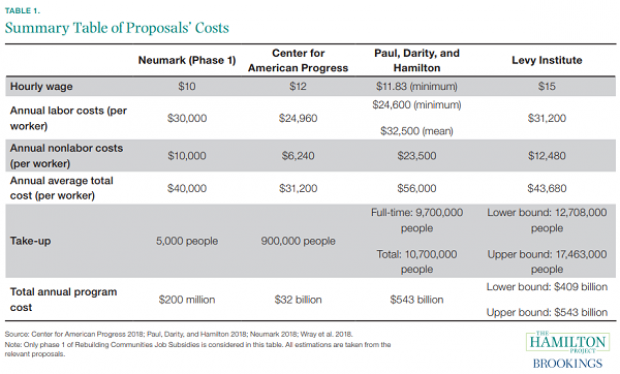One of the more provocative ideas being kicked around on the progressive left these days is a federal jobs guarantee. Proponents say that too many American workers have been left behind in an increasingly service-oriented economy, leaving millions unemployed or underemployed, struggling just to survive with little hope for the future. The federal government should step in to correct this market failure, the theory goes, offering jobs to all who want them, thereby providing dignified work and livable wages while reviving the many rural and industrial communities that have suffered from economic stagnation or collapse over the last few decades.
While the idea has plenty of critics on both the left and the right – see here and here, for example – several liberal think tanks have offered serious proposals for how a jobs guarantee might operate, and earlier this year Sen. Cory Booker (D-NJ) released a bill that would create a pilot program.
The Hamilton Project at the Brookings Institution just released a new analysis of several leading proposals for a federal jobs guarantee, including those from the Center for American Progress and the Levy Institute. The Brookings analysis delves into some of the many sticky issues surrounding the idea, such as its effect on the overall job market, its potential size and, crucially, its likely cost. Here are some of the data and conclusions from the report:
* The potential size of the program is enormous. There are currently about 50 million working-age people who are unemployed or out of the workforce altogether, and roughly another 50 million who are employed but making less than $15 an hour (see the table below).
* Not all potential participants would actually sign up, and much depends on the wages offered, with proposals ranging from $10 an hour to $15 an hour, with variable benefits.
* The roughly 6 million workers who are currently unemployed would likely participate at high levels, along with several million low-wage workers who would switch jobs. Some people currently out of the workforce would take jobs as well.
* Some employed workers who could switch to the federal program would stay in their current jobs, though at higher wages sparked by the competition from the jobs guarantee.
* In one projection, the U-6 unemployment rate, which includes the unemployed, marginally attached workers and some part-timers, would fall sharply to 1.5 percent, down from its current 9.7 percent – with nearly 10 million people gaining full-time work.
* Wages for the bottom 80 percent of workers would rise by as much as 5 percent, and poverty rates would fall.
* Participation would likely vary significantly by geography.
* The kind of work that could be done by participants includes teachers and teaching assistants, personal care providers, construction and maintenance workers, security and police forces, and office support.
* The costs would likely be in the billions of dollars, with two of the more aggressive proposals coming in at more than $500 billion per year (see the table below).
The bottom line: A full-scale federal jobs guarantee would likely attract millions of participants and cost hundreds of billions annually, while dramatically reducing unemployment and underemployment for American workers. There is considerable uncertainty, however, about how such a program would operate in the real world and how it would affect the overall U.S. job market.



